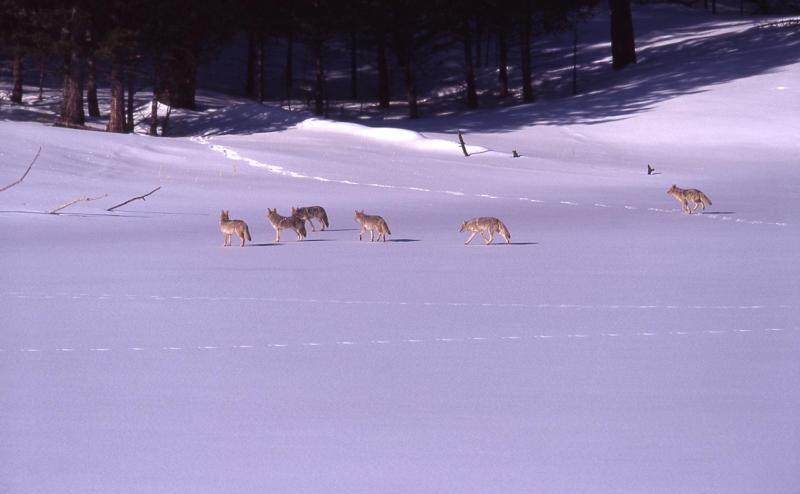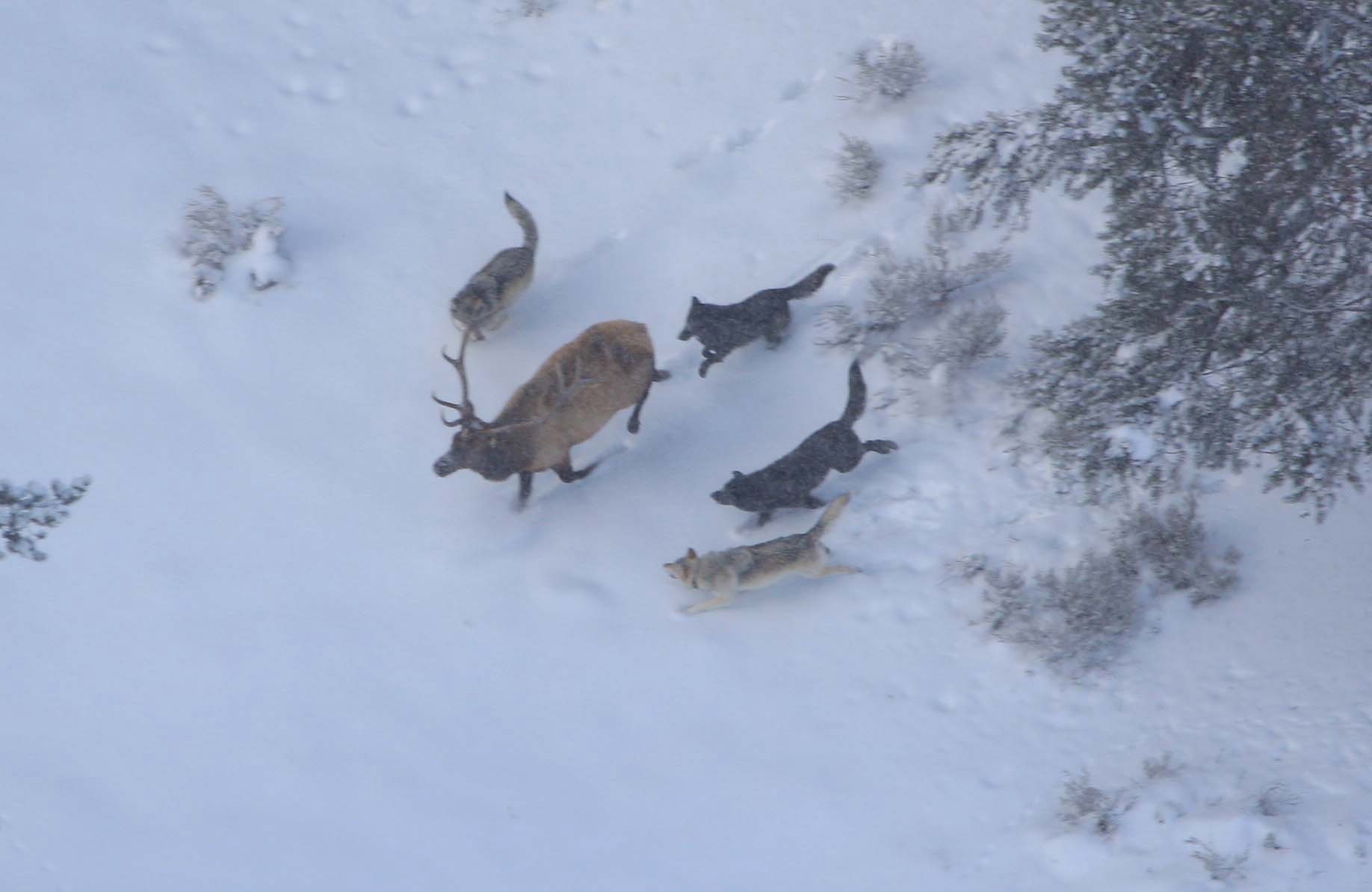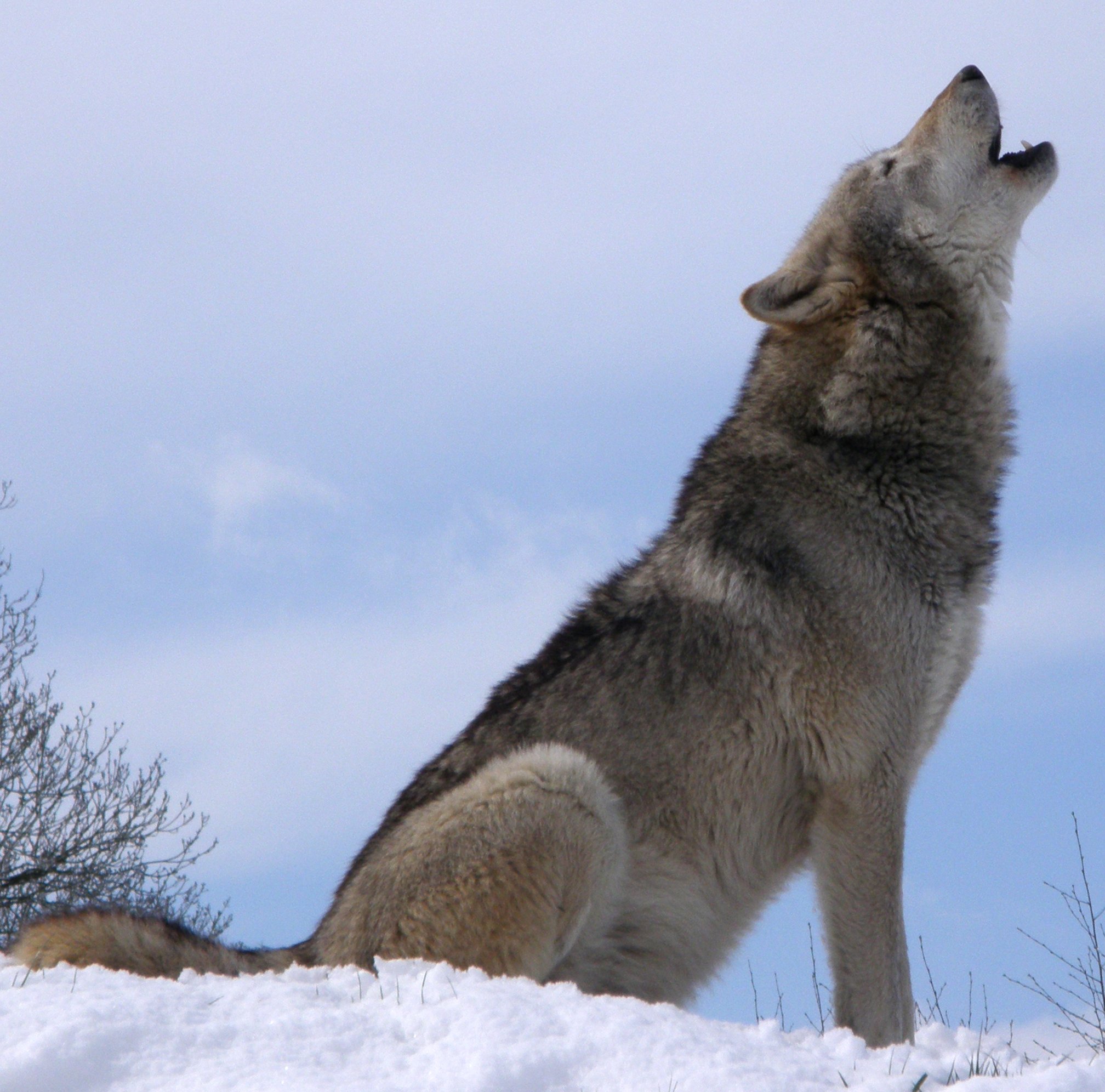|
Wolf
The wolf (''Canis lupus''; : wolves), also known as the gray wolf or grey wolf, is a large canine native to Eurasia and North America. More than thirty subspecies of ''Canis lupus'' have been recognized, and gray wolves, as popularly understood, comprise wild subspecies. The wolf is the largest extant member of the family Canidae. It is also distinguished from other '' Canis'' species by its less pointed ears and muzzle, as well as a shorter torso and a longer tail. The wolf is nonetheless related closely enough to smaller ''Canis'' species, such as the coyote and the golden jackal, to produce fertile hybrids with them. The banded fur of a wolf is usually mottled white, brown, gray, and black, although subspecies in the arctic region may be nearly all white. Of all members of the genus ''Canis'', the wolf is most specialized for cooperative game hunting as demonstrated by its physical adaptations to tackling large prey, its more social nature, and its highly adv ... [...More Info...] [...Related Items...] OR: [Wikipedia] [Google] [Baidu] |
Subspecies Of Canis Lupus
There are 38 subspecies of ''Canis lupus'' listed in the taxonomic authority '' Mammal Species of the World'' (2005, 3rd edition). These subspecies were named over the past 250 years, and since their naming, a number of them have gone extinct. The nominate subspecies is the Eurasian wolf (''Canis lupus lupus''). Taxonomy In 1758, the Swedish botanist and zoologist Carl Linnaeus published in his ''Systema Naturae'' the binomial nomenclature – or the two-word naming – of species. ''Canis'' is the Latin word meaning "dog", and under this genus he listed the dog-like carnivores including domestic dogs, wolves, and jackals. He classified the domestic dog as ''Canis familiaris'', and on the next page he classified the wolf as ''Canis lupus''. Linnaeus considered the dog to be a separate species from the wolf because of its head and body and tail ''cauda recurvata'' - its upturning tail - which is not found in any other canid. In 1999, a study of mitochondrial DNA indicated that ... [...More Info...] [...Related Items...] OR: [Wikipedia] [Google] [Baidu] |
Coyote
The coyote (''Canis latrans'') is a species of canine native to North America. It is smaller than its close relative, the wolf, and slightly smaller than the closely related eastern wolf and red wolf. It fills much of the same ecological niche as the golden jackal does in Eurasia. The coyote is larger and more predatory and was once referred to as the American jackal by a behavioral ecologist. Other historical names for the species include the prairie wolf and the brush wolf. The coyote is listed as least concern by the International Union for Conservation of Nature, due to its wide distribution and abundance throughout North America. The species is versatile, able to adapt to and expand into environments modified by humans. It is enlarging its range by moving into urban areas in the eastern U.S. and Canada. The coyote was sighted in eastern Panama (across the Panama Canal from their home range) for the first time in 2013. The coyote has 19 recognized subspecies. The average ... [...More Info...] [...Related Items...] OR: [Wikipedia] [Google] [Baidu] |
Eurasian Wolf
The Eurasian wolf (''Canis lupus lupus''), also known as the common wolf,Mech, L. David (1981), ''The Wolf: The Ecology and Behaviour of an Endangered Species'', University of Minnesota Press, p. 354, is a subspecies of grey wolf native to Europe and Asia. It was once widespread throughout Eurasia prior to the Middle Ages. Aside from an extensive paleontological record, Indo-European languages typically have several words for "wolf", thus attesting to the animal's abundance and cultural significance.Gamkrelidze, T. V. & Ivanov, V. V. (1995), ''Indo-European and the Indo-Europeans: A Reconstruction and Historical Analysis of a Proto-Language and Proto-Culture'', Walter de Gruyter, pp. 413-417, It was held in high regard in Baltic, Celtic, Slavic, Turkic, ancient Greek, Roman, and Thracian cultures, whilst having an ambivalent reputation in early Germanic cultures. It is the largest of Old World grey wolves, averaging in Europe; however, exceptionally large individuals have w ... [...More Info...] [...Related Items...] OR: [Wikipedia] [Google] [Baidu] |
Canis
''Canis'' is a genus of the Caninae which includes multiple extant species, such as wolves, dogs, coyotes, and golden jackals. Species of this genus are distinguished by their moderate to large size, their massive, well-developed skulls and dentition, long legs, and comparatively short ears and tails.Heptner, V. G.; Naumov, N. P. (1998). ''Mammals of the Soviet Union'' Vol.II Part 1a, SIRENIA AND CARNIVORA (Sea Cows, Wolves and Bears). Science Publishers, Inc. USA. pp. 124–129. . Taxonomy The genus ''Canis'' ( Carl Linnaeus, 1758) was published in the 10th edition of Systema Naturae and included the dog-like carnivores: the domestic dog, wolves, coyotes and jackals. All species within ''Canis'' are phylogenetically closely related with 78 chromosomes and can potentially interbreed. In 1926, the International Commission on Zoological Nomenclature (ICZN) in Opinion 91 included Genus ''Canis'' on its ''Official Lists and Indexes of Names in Zoology''. In 1955, the ICZN's Dire ... [...More Info...] [...Related Items...] OR: [Wikipedia] [Google] [Baidu] |
Canid Hybrid
Canid hybrids are the result of interbreeding between the species of the genus '' Canis''. This often occurs in the wild, and in particular between domestic or feral dogs with wild native canids. Genetic considerations The wolf-like canids are a group of large carnivores that are genetically closely related because they all possess 78 chromosomes, arranged in 39 pairs and are karyologically indistinguishable from each other. The group includes the genera ''Canis'', ''Cuon'', ''Lupulella'' and ''Lycaon''. The members are the domestic dog ''(C. familiaris)'', gray wolf (''C. lupus''), dingo (''C. lupus dingo''), coyote (''C. latrans''), golden jackal (''C. aureus''), African wolf (''C. lupaster''), Ethiopian wolf (''C. simensis''), dhole (''Cuon alpinus''), black-backed jackal (''Lupulella mesomelas''), side-striped jackal (''L. adusta'') and African wild dog (''Lycaon pictus''). Newly proposed members include the red wolf (''Canis rufus''), and the eastern wolf (''Canis lycao ... [...More Info...] [...Related Items...] OR: [Wikipedia] [Google] [Baidu] |
Golden Jackal
The golden jackal (''Canis aureus''), also called common jackal, is a wolf-like canid that is native to Southeast Europe, Southwest Asia, South Asia, and regions of Southeast Asia. The golden jackal's coat varies in color from a pale creamy yellow in summer to a dark tawny beige in winter. It is smaller and has shorter legs, a shorter tail, a more elongated torso, a less-prominent forehead, and a narrower and more pointed muzzle than the Arabian wolf. It is listed as Least Concern on the IUCN Red List due to its widespread distribution and high density in areas with plenty of available food and optimum shelter. Despite its name, the golden jackal is not closely related to the African black-backed jackal or side-striped jackal, which are part of the genus ''Lupulella''. It is instead closer to wolves and coyotes. The ancestor of the golden jackal is believed to be the extinct Arno river dog that lived in southern Europe . It is described as having been a small, jackal-like ... [...More Info...] [...Related Items...] OR: [Wikipedia] [Google] [Baidu] |
Pack (canine)
A pack is a social group of conspecific canines. Packs aren't formed by all canines, especially small sized canines like the Red fox. The number of members in a pack and their social behavior varies from species to species. Social structure is very important in a pack. Every pack member will have a position and a role to play. Canine packs are led by a breeding pair, consisting of the alpha male and the alpha female. Pack behavior in specific species African wild dogs (''Lycaon pictus'') live and hunt in packs. Males assist in raising the pups, and remain with their pack for life, while the females leave their birth pack at about the age of two and a half years old to join a pack with no females. Males outnumber the females in a pack, and usually only one female is present to breed with all males. African wild dogs are not territorial, and they hunt cooperatively in their packs, running down large game and tearing it apart. They cooperate in caring for wounded and sick pack me ... [...More Info...] [...Related Items...] OR: [Wikipedia] [Google] [Baidu] |
Canidae
Canidae (; from Latin, '' canis'', " dog") is a biological family of dog-like carnivorans, colloquially referred to as dogs, and constitutes a clade. A member of this family is also called a canid (). There are three subfamilies found within the canid family, which are the extinct Borophaginae and Hesperocyoninae, and the extant Caninae. The Caninae are known as canines, and include domestic dogs, wolves, coyotes, foxes, jackals and other extant and extinct species. Canids are found on all continents except Antarctica, having arrived independently or accompanied human beings over extended periods of time. Canids vary in size from the gray wolf to the fennec fox. The body forms of canids are similar, typically having long muzzles, upright ears, teeth adapted for cracking bones and slicing flesh, long legs, and bushy tails. They are mostly social animals, living together in family units or small groups and behaving cooperatively. Typically, only the dominant pair in a ... [...More Info...] [...Related Items...] OR: [Wikipedia] [Google] [Baidu] |
Hunting Behavior Of Gray Wolves
Single wolves or mated pairs typically have higher success rates in hunting than do large packs; single wolves have occasionally been observed to kill large prey such as moose, bison and muskoxen unaided. This contrasts with the commonly held belief that larger packs benefit from cooperative hunting to bring down large game. The size of a wolf hunting pack is related to the number of pups that survived the previous winter, adult survival, and the rate of dispersing wolves leaving the pack. The optimal pack size for hunting elk is four wolves, and for bison a large pack size is more successful. As well as their physical adaptations for hunting hoofed mammals, wolves possess certain behavioural, cognitive, and psychological adaptations to assist with their hunting lifestyle. Wolves are excellent learners that match or outperform domestic dogs. They can use gaze to focus attention on where other wolves are looking. This is important because wolves do not use vocalization when hunting. ... [...More Info...] [...Related Items...] OR: [Wikipedia] [Google] [Baidu] |
Wolf Communication
Wolves communicate using vocalizations, body postures, scent, touch, and taste. The lunar phases have no effect on wolf vocalisation. Despite popular belief, wolves do not howl at the Moon. Gray wolves howl to assemble the pack, usually before and after hunts, to pass on an alarm particularly at a den site, to locate each other during a storm or while crossing unfamiliar territory, and to communicate across great distances. Other vocalisations include growls, barks and whines. Wolves do not bark as loudly or continuously as dogs do but they bark a few times and then retreat from a perceived danger. Aggressive or self-assertive wolves are characterized by their slow and deliberate movements, high body posture and raised hackles, while submissive ones carry their bodies low, sleeken their fur, and lower their ears and tail. Raised leg urination is considered to be one of the most important forms of scent communication in the wolf, making up 60–80% of all scent marks observed. ... [...More Info...] [...Related Items...] OR: [Wikipedia] [Google] [Baidu] |
Howling
Howling is a vocal form of animal communication seen in most canines, particularly wolves, coyotes, foxes, and dogs, as well as cats and some species of monkeys. Howls are generally lengthy sustained sounds, loud and audible over long distances, often with some variation in pitch over the length of the sound. Howling is generally used by animals that engage in this behavior to signal their positions to one another, to call the pack to assemble, or to note their territory. The behavior is occasionally copied by humans, and has been noted to have varying degrees of significance in human culture. In canines The long-distance howling of wolves and coyotes is one way in which canines communicate. Long-distance contact calls are common in Canidae, typically in the form of either barks (termed "pulse trains") or howls (termed "long acoustic streams"). Wolves howl to assemble the pack usually before and after hunts, to pass on an alarm particularly at a den site, to locate each ... [...More Info...] [...Related Items...] OR: [Wikipedia] [Google] [Baidu] |
Territory (animal)
In ethology, territory is the sociographical area that an animal consistently defends against conspecific competition (or, occasionally, against animals of other species) using agonistic behaviors or (less commonly) real physical aggression. Animals that actively defend territories in this way are referred to as being territorial or displaying territorialism. Territoriality is only shown by a minority of species. More commonly, an individual or a group of animals occupies an area that it habitually uses but does not necessarily defend; this is called its home range. The home ranges of different groups of animals often overlap, and in these overlap areas the groups tend to avoid each other rather than seeking to confront and expel each other. Within the home range there may be a ''core area'' that no other individual group uses, but, again, this is as a result of avoidance. Function The ultimate function of animals inhabiting and defending a territory is to increase the indi ... [...More Info...] [...Related Items...] OR: [Wikipedia] [Google] [Baidu] |
.png)
_C._l._albus_mod.jpg)


.png)

.jpg)


.jpg)
